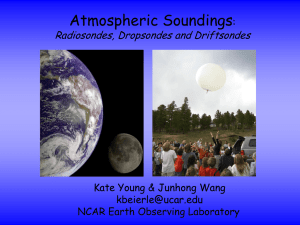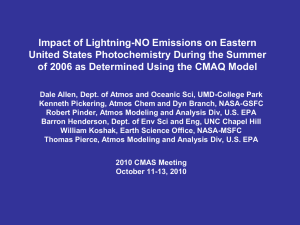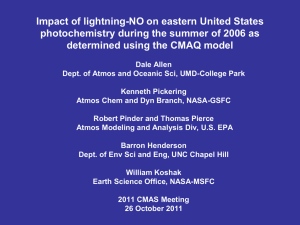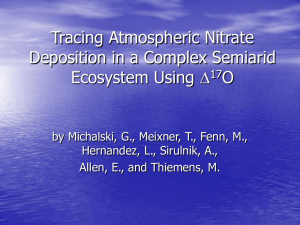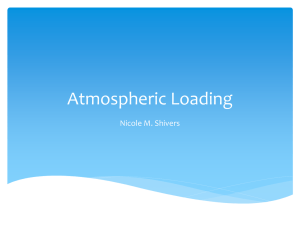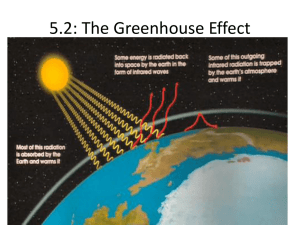Why ISORROPIA II?
advertisement
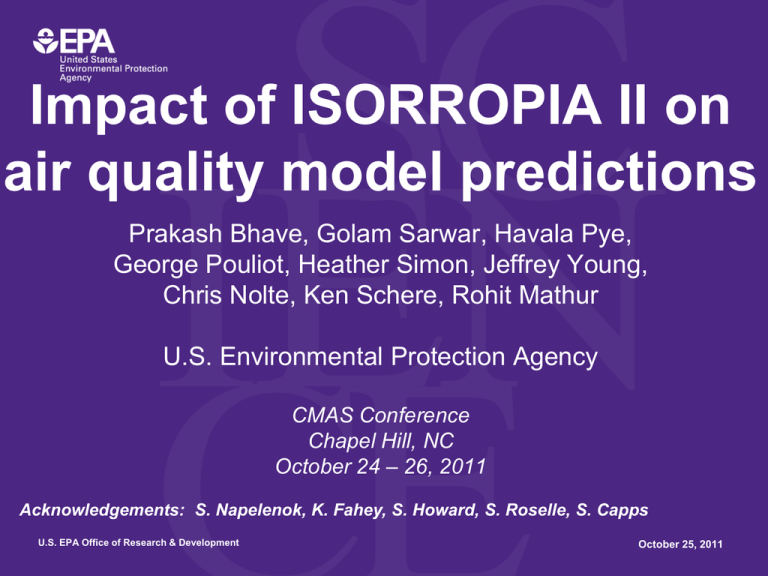
Impact of ISORROPIA II on air quality model predictions Prakash Bhave, Golam Sarwar, Havala Pye, George Pouliot, Heather Simon, Jeffrey Young, Chris Nolte, Ken Schere, Rohit Mathur U.S. Environmental Protection Agency CMAS Conference Chapel Hill, NC October 24 – 26, 2011 Acknowledgements: S. Napelenok, K. Fahey, S. Howard, S. Roselle, S. Capps U.S. EPA Office of Research & Development October 25, 2011 Overview 1. What is ISORROPIA? 2. Motivation for ISORROPIA II 3. Implementation in CMAQ v5.0β • model results interspersed throughout 4. Summary & Future Work 1 U.S. EPA Office of Research & Development, Atmospheric Modeling & Analysis Division What is ISORROPIA? • Inorganic, gas/particle, thermodynamic, equilibrium module embedded in numerous air quality models (e.g., CMAQ, GEOS-Chem, CAMx, CHIMERE) –Computationally efficient –Consumes <10% of CMAQ model run time –Fun facts: • Developed by Thanos Nenes for his Masters thesis! • ISORROPIA means equilibrium in Greek • In CMAQ, subroutine is purposely misspelled ISOROPIA U.S. EPA Office of Research & Development, Atmospheric Modeling & Analysis Division What is ISORROPIA? • Schematic of PM species in CMAQ’s AE5 module • ISORROPIA I treats SO4/NO3/NH4/Na/Cl/H2O system HNO3 EC POC NO3NH4+ = SOA SO4 Na+ equiv’s Cl- SVOCs Other NO3NH4+ SO42ClNa+ equivalents NH3 H2SO4 Soil & PMCanth HCl H 2O H 2O H 2O 2 FINE MODES U.S. EPA Office of Research & Development, Atmospheric Modeling & Analysis Division COARSE MODE Why ISORROPIA II? Motivation #1: Numerical Stability In previous versions of CMAQ, doubling EC emissions in Massachusetts could cause a 1.7mg/m3 increase in NO3- over California. • This erroneous result was primarily due to ISORROPIA I ΔEC U.S. EPA Office of Research & Development, Atmospheric Modeling & Analysis Division ΔNO3- Why ISORROPIA II? Motivation #2: Coarse NO3 Bias Grand Canyon National Park: May 1 – 31, 2003 (n = 15) Great Smoky Mountains NP: July 22 – Aug. 19, 2004 (n = 14) NH4+ Na+ NO3- Cl- Mass concentration dM/dlnD p (μg/m3) Mass concentration dM/dlnD p (μg/m3) SO4= SO4= Aerodynamic diameter (μm) NH4+ Na+ NO3- Cl- Aerodynamic diameter (μm) Reference: CMAS poster by Bhave & Appel (2009) • Hypothesis: bias is due to CMAQ’s treatment of crustal species (ASOIL, ACORS) as thermodynamically inactive. U.S. EPA Office of Research & Development, Atmospheric Modeling & Analysis Division Why ISORROPIA II? • Optimized activity coefficient calculations – to minimize model runtime and improve numerical stability • Treats thermodynamics of crustal materials – Mg2+, K+, Ca2+ – MgSO4, Mg(NO3)2, MgCl2, K2SO4, KHSO4, KNO3, KCl, CaSO4, Ca(NO3)2, CaCl2 • Peer-reviewed literature: Fountoukis & Nenes (ACP, 2007) • ISORROPIA versions released in CMAQ CMAQ v4.5 v4.6 v5.0 ISORROPIA v1.5 v1.7 v2.1 U.S. EPA Office of Research & Development, Atmospheric Modeling & Analysis Division Implementation in CMAQ v5.0β HNO3 EC POC SOA NO3NH4+ SO4 Na+ = ClSVOCs Other NO3NH4+ SO42ClNa+ equivalents NH3 H2SO4 Soil & PMCanth HCl H 2O H 2O H 2O 2 FINE MODES U.S. EPA Office of Research & Development, Atmospheric Modeling & Analysis Division COARSE MODE Implementation in CMAQ v5.0β • Revised coarse-mode mass transfer (new species shown in red) HNO3 EC POC NCOM SOA SVOCs NO3NH4+ = SO4 Na+, Mg2+, K+, Ca2+ Fe, Al, Si, ClTi, Mn, Other H 2O NH3 NO3NH4+ SO42ClSEACAT includes Na+,Mg2+,K+,Ca2+ H2SO4 Soil & PMCanth also include Na+,Mg2+,K+,Ca2+ HCl H 2O H 2O 2 FINE MODES U.S. EPA Office of Research & Development, Atmospheric Modeling & Analysis Division COARSE MODE Implementation in CMAQ v5.0β 1. Compare ISORROPIA v2.1 versus v1.7 2. Evaluate numerical stability Zero emissions of K, Ca, & Mg, to compare with ISORROPIA v1.7 3. Add new species to CMAQ: Mg, K, Ca 9 U.S. EPA Office of Research & Development, Atmospheric Modeling & Analysis Division ISORROPIA v1.7 vs. v2.1 10-day Summer Test Case (new – old) ΔPM2.5 µg m-3 ΔO3 ppb ΔPM2.5 is driven by a NO3- decrease • v2.1 partitions more NH3 & HNO3 to gas phase than v1.7 in warm season. ΔO3 is very small, a side effect of ΔHNO3. U.S. EPA Office of Research & Development, Atmospheric Modeling & Analysis Division ISORROPIA v1.7 vs. v2.1 10-day Winter Test Case (new – old) ΔPM2.5 ΔPM2.5 is larger and more widespread during winter driven by a NO3increase • opposite of summer result ΔO3 is negligible Remainder: focus on winter test period µg m-3 U.S. EPA Office of Research & Development, Atmospheric Modeling & Analysis Division ISORROPIA v1.7 vs. v2.1 Test of Numerical Stability ΔEC Doubled EC emission rate in a Massachusetts grid cell (right), and plotted the domainwide ΔNO3- (below) v1.7 v2.1 * Numerical stability of ISORROPIA v2.1 is greatly enhanced relative to v1.7 U.S. EPA Office of Research & Development, Atmospheric Modeling & Analysis Division Add New Species to CMAQ: Mg, K, Ca Step 1. Anthropogenic PM2.5 Σ Mg, K, Ca Fine-particulate crustal cations are concentrated in Midwest and urban areas: road dust, ag soil, construction U.S. EPA Office of Research & Development, Atmospheric Modeling & Analysis Division Add New Species to CMAQ: Mg, K, Ca Step 2. Speciation of Sea Salt SO4 7.7% Other 0.6% Na 30.7% • Previously, we had to scale up Na+ emissions from sea salt to balance the negative charges of Cl- & SO42because CMAQ could not track Mg, K, and Ca. • In CMAQv5.0 AE6, fine-particulate sea salt is entirely speciated into Na, Mg, K, Ca, Cl, and SO4. Mg 3.6% Cl 55.0% Fine-mode Speciation Ca 1.2% K 1.1% • To minimize #transported spcs in CMAQv5.0, coarse sea salt is speciated into Cl, SO4, and a new lumped species (ASEACATK) that represents total sea-salt cations. • ASEACAT is disaggregated in CMAQ only when individual species are needed (e.g., ISORROPIA, CLDPROC, postproc) U.S. EPA Office of Research & Development, Atmospheric Modeling & Analysis Division Add New Species to CMAQ: Mg, K, Ca Step 3. Speciation of Coarse PM Emissions NO3 Cl NH4 H2O SO4 Na Mg Al Si Other K Ca EC NCOM OC Ti Mn Fe Anthropogenic PMC • In NEI, anthropogenic coarse PM (PMC) is dominated by • Unpaved Road Dust (47.5%) • Agricultural Soil (25.3%) • Paved Road Dust (11.4%) • Construction Dust (9.6%) • Mining & Quarrying Dust (6.1%) • PM10-2.5 profiles taken from SPECIATE database, for sources above • Composite speciation profile shown on left U.S. EPA Office of Research & Development, Atmospheric Modeling & Analysis Division Add New Species to CMAQ: Mg, K, Ca Step 3. Speciation of Coarse PM Emissions NO3 Cl • 5 coarse-mode species are tracked explicitly in CMAQ. NH4 H2O SO4 Na Mg Al Si Other K Ca EC NCOM OC Ti Mn Fe Anthropogenic PMC U.S. EPA Office of Research & Development, Atmospheric Modeling & Analysis Division • Rest are lumped into ACORS & disaggregated only when needed within CMAQ Add New Species to CMAQ: Mg, K, Ca Step 3. Speciation of Coarse PM Emissions • Speciation profile (left) is composited from 4 desert soil PM10-2.5 profiles in SPECIATE database. Cl NH4 H2O NO3 SO4 Na Mg Al • Only SO4, NO3, Cl, NH4, & H2O are tracked explicitly in CMAQ. • Rest are disaggregated from ASOIL only when needed in CMAQ. Si Other K Ca OC EC Ti Mn Fe NCOM Coarse Windblown Dust U.S. EPA Office of Research & Development, Atmospheric Modeling & Analysis Division CMAQ Results 10-day Winter Test Case (new – old) Coarse NO3 (ANO3K) Fine NO3 (ANO3I+J) Left. The increase in ANO3K across the Midwest and central California is likely due to partitioning of HNO3 to coarse soil/dust particles. Right. We see a corresponding decrease in fine-mode NO3 at the same locations. Not shown. Other species are affected to a much smaller degree. U.S. EPA Office of Research & Development, Atmospheric Modeling & Analysis Division Summary • Compared to v1.7, ISORROPIA v2.1 … – is more numerically stable! – puts slightly more NO3- in the gas phase during summer. – puts slightly more NO3- in particle phase during winter. • ISORROPIA v2.1 is fully implemented in CMAQ v5.0, taking advantage of its capabilities to handle Mg, K, & Ca. • In CMAQv5.0, coarse-mode NO3 increases inland, at the expense of fine NO3. Future Work • Evaluate CMAQv5.0 against impactor measurements • Refine estimates of coarse PM emissions • Explore computational burden of v2.1 – prelim analysis suggests 12% slowdown U.S. EPA Office of Research & Development, Atmospheric Modeling & Analysis Division 19 Appendix 20 U.S. EPA Office of Research & Development, Atmospheric Modeling & Analysis Division CMAQ details • CMAQv4.7.1 uses ISORROPIA 1.7 • Implemented ISORROPIA 2.1 in CMAQv4.7.1 • Test period covered for 10 days in 2002 – January - winter – July - summer • Continental US domain with 36-KM grid-cells • Used same IC and BC • Several tests were conducted (with ISORROPIA 1.7 & ISORROPIA 2.1) – Normal emissions (without Ca, Mg, and K) – Sensitivity runs by doubling EC emission in one grid-cell in Massachusetts – Normal emissions + Ca, Mg, and K; however these were not included in ISORROPIA – Normal emissions + Ca, Mg, and K; these were included in ISORROPIA U.S. EPA Office of Research & Development, Atmospheric Modeling & Analysis Division


